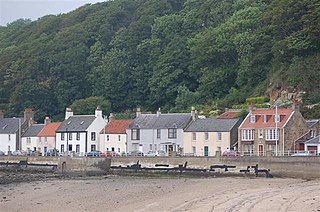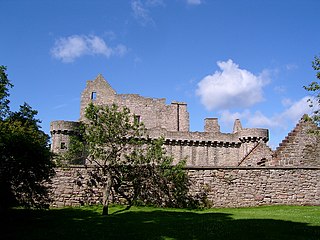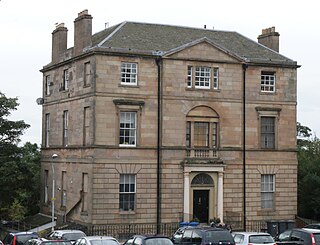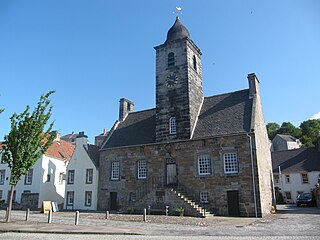
Fife is a council area, historic county, registration county and lieutenancy area of Scotland. It is situated between the Firth of Tay and the Firth of Forth, with inland boundaries with Perth and Kinross and Clackmannanshire. By custom it is widely held to have been one of the major Pictish kingdoms, known as Fib, and is still commonly known as the Kingdom of Fife within Scotland. A person from Fife is known as a Fifer. In older documents the county was very occasionally known by the anglicisation Fifeshire.

Dunfermline is a city, parish and former Royal Burgh, in Fife, Scotland, on high ground 3 miles (5 km) from the northern shore of the Firth of Forth. The city currently has an estimated population of 58,508. According to the National Records of Scotland, the Greater Dunfermline area has a population of 76,210.

Kirkcaldy is a town and former royal burgh in Fife, on the east coast of Scotland. It is about 11.6 miles (19 km) north of Edinburgh and 27.6 miles (44 km) south-southwest of Dundee. The town had a recorded population of 49,460 in 2011, making it Fife's second-largest settlement and the 12th most populous settlement in Scotland.

Inverkeithing is a port town and parish, in Fife, Scotland, on the Firth of Forth. A town of ancient origin, Inverkeithing was given royal burgh status during the reign of Malcolm IV in the 12th century. It was an important center of trade during the Middle Ages, and its industrial heritage built on quarrying and ship breaking goes back to the 19th century. In 2016, the town had an estimated population of 4,890, while the civil parish was reported to have a population of 8,090 in 2011.

Limekilns is a village in Fife, Scotland. It lies on the shore of the Firth of Forth, around 3 miles (5 km) south of Dunfermline.

Dunfermline Palace is a ruined former Scottish royal palace and important tourist attraction in Dunfermline, Fife, Scotland. It is currently, along with other buildings of the adjacent Dunfermline Abbey, under the care of Historic Environment Scotland as a scheduled monument.

Craigmillar Castle is a ruined medieval castle in Edinburgh, Scotland. It is three miles (4.8 km) south-east of the city centre, on a low hill to the south of the modern suburb of Craigmillar. The Preston family of Craigmillar, the local feudal barons, began building the castle in the late 14th century and building works continued through the 15th and 16th centuries. In 1660, the castle was sold to Sir John Gilmour, Lord President of the Court of Session, who breathed new life into the ageing castle. The Gilmours left Craigmillar in the 18th century for a more modern residence, nearby Inch House, and the castle fell into ruin. It is now in the care of Historic Environment Scotland as a scheduled monument, and is open to the public.

Elizabeth, Lady Wardlaw (1677–1727) was a Scottish poet and the reputed author of the ballad Hardyknute.

Fordell Castle is a restored 16th-century tower house, located 1.25 miles (2.01 km) north-west of Dalgety Bay and 2 miles (3.2 km) east of Dunfermline, in Fife, Scotland. Parts of the castle date from before 1566, though most dates from 1580 or later. The chapel was rebuilt in 1650. The interior of the castle was substantially renovated in the 1960s, with additional major renovations to the castle interiors and chapel in the early 2000s. The estate is in private ownership and not available for public tour.

Tulliallan was an estate in Perthshire, Scotland, near to Kincardine, and a parish. The Blackadder lairds of Tulliallan, a branch of the Blackadder border clan, wielded considerable power in the 15th and 16th centuries. The modern Tulliallan Castle is relatively recent, built in 1812-1820 and now the home of the Scottish Police College

Dunfermline High School is one of four main high schools located in Dunfermline, Fife, Scotland. The school also caters for pupils from Kincardine, Rosyth and surrounding villages. The school was founded in 1468. Today it has over 1,550 pupils. The current Rector is Iain Yuile.

Balcarres House lies 1km north of the village of Colinsburgh, in the East Neuk of Fife, in eastern Scotland. It is centred on a mansion built in 1595 by John Lindsay (1552–1598), second son of David, 9th Earl of Crawford. The house became the family seat of the Earl of Crawford. The present house is the result of substantial extensions in the early nineteenth century, using part of a fortune made in India, but preserves much of the original mansion.

Royal Air Force Pitreavie Castle or RAF Pitreavie Castle was a station of the Royal Air Force located at Pitreavie Castle in Dunfermline and near Rosyth, Fife, Scotland.

Viewfield House is a large square stone built three storey Palladian villa in Dunfermline, Fife, Scotland. It is a category B listed building.
Ministry of Defence Caledonia is a military establishment of the Ministry of Defence based at the former Royal Naval Dockyard, Rosyth in Scotland.

Henry Wardlaw of Pitreavie (1565–1637) was a Scottish courtier and administrator.

Dowhill Castle is a ruined castle in Perth and Kinross, Scotland. Sited on a hill near Loch Leven, the oldest part of the castle was built in around 1500 as a tower house. The main structure was extended in around 1600 with additional living space, as well as a tower and turret. The castle had a fortified courtyard (barmkin) to the north with a separate tower. There were probably four storeys but only two still survive.

Culross Town House, also known as Culross Tolbooth, is a municipal structure in the Sandhaven area of Culross, Fife, Scotland. The building, which now serves as a visitor centre, is Category A listed.



















